I kept finding these intimidating looking plaques inset into the sidewalks everywhere and I’ll admit my first reaction was one of indignation.
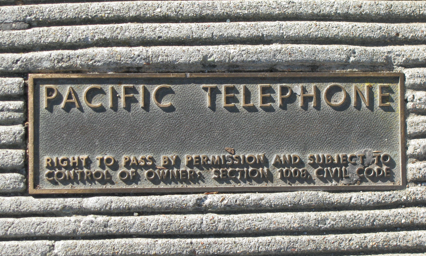
What, are sidewalks not even considered public space anymore? Am I allowed to tread on them only by the grace of the nearby property owner? I, like so many others, directed the sheer force of my anger into the Google search engine and discovered that a lot of people were asking the same general question. After a bit of digging, I discovered that the answer is a lot less sinister than I had inferred. Pursuant to a State of California Civil Code (other states and cities have similar codes), property owners are required to post such notices to prevent someone claiming ownership of their land through continued use (known as an easement). In this case, the building nearby has a sizable plaza area, and someone could claim, simply because they’ve crossed the space regularly for a number of years the legal right to that space’s use. Case closed then.
Not so fast.
It turns out that the ambiguity of the wording of the plaques, mixed in with a little Post-9/11 hysteria, have had a chilling effect on the use of public space. Here in San Francisco, citizens are savvy enough to not leave well enough alone, but the message is clear: just as property owners could be in danger of losing slices of their real estate, we are well advised to exercise our right to public space or risk watching it evaporate due to our irresolution.
For example, here’s the view from 2nd and Harrison:
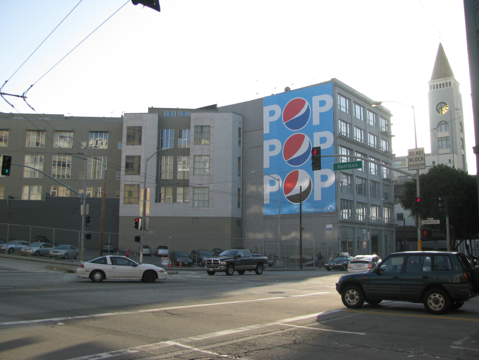
Not far away but in a less trafficked area you can find this:
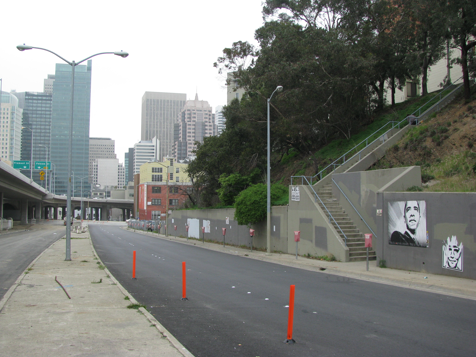
I know which I’d rather look at, but the fact remains that the latter work, by a street artist named Eddie, is where it is because the act of posting it is illegal.
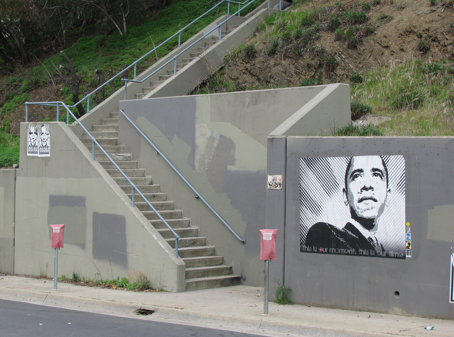
There’s an irony in the fact that the former is so prominently displayed considering it’s a direct riff off Shepard Fairey’s “Hope” campaign posters. Fairey certainly has had no end of trouble both because of his guerilla tagging efforts and because of the appropriation of images (the Pepsi campaign is also a nod to Pop Art in general, which makes the whole business even more absurd).

I found it interesting to discover recently that the genesis of Fairey’s methods sprang in part from the John Carpenter flick They Live. It’s a personal favorite and comes from an era when even the most frivolous of entertainment came with a subversive undercurrent warning of everything from creeping facism and corporate greed to the military-industrial complex (Blue Thunder, Short Circuit, Alien, Robocop, Real Genius, et al.)
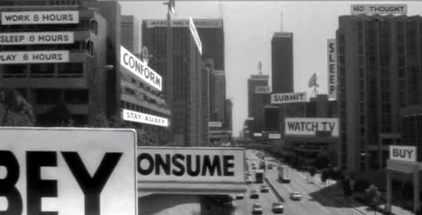
It’s small wonder that he would find inspiration in propaganda art and yet seek to invade commercial space with his early work. In They Live, the two are presented as nearly indistinguishable. What Fairey’s art evolved into is brilliant in its simplicity: a stylized image of wrestler Andre the Giant’s face paired with the bold capitalized injunction “Obey.” Since it offered a critique of the encroachment of advertisement into every available square foot of visible space, it was necessary that it occupy the same landscape. The nonsensical “message” was essential. Just as the images and copy on advertising were ciphers, Fairey’s work was an attempt to cause a short circuit in our brains, to stop and consider the disjunction between what we saw and the subliminal cues we were receiving. It was art that did not want to be understood.
While Fairey never abandoned the appropriation of images as a starting point, his work has reached a baroque phase of sublime beauty.
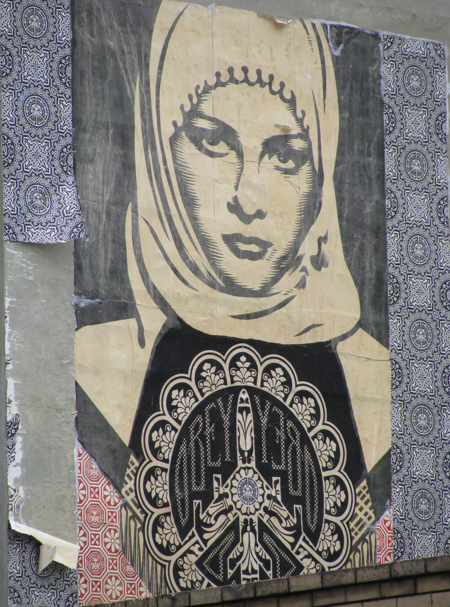
Before you jump to conclusions like I did that the above work is another authorities-defying proof of performance, I hasten to point out that it is, for all intents and purposes, an advertisement.

The wheat pasted artwork you can see above Le Central from the Chinatown Gate is affixed to the side of the Hotel des Arts, which features a Shepard Fairey room. Fairey has reached a point where he is well known enough that he can receive commissions for his work. But what about the next Shepard Fairey? What will she do?
The fact of the matter is that advertisements have every right to be where they are. They after all pay for the use of space. But their proliferation transformed our environment. Previously, when one talked of public space they probably had a square or city park in mind. To be honest, having a share in the available visible space probably never occurred to anyone.
But people want to participate in their culture, it’s inevitable. Since popular culture and mass culture have fused, much of our mental landscape is dominated by images and themes that we have no ownership over. Browse through the lists compiled by Slash Film of “Cool Stuff” and you will find an inexhaustible outpouring of creativity by individuals, nearly all of it inspired by a licensed property. No one seems overly upset about their “appropriation” of images, however interpreted or stylized.
Nor would anyone likely show the rancor they do toward Fairey’s tagging if they saw someone put up a flyer for their missing dog or a garage sale on the same real estate. If the only place that art endures is in neglected backstreets, people are liable to draw conclusions based on their surroundings. I will unashamedly admit that I wholeheartedly love stuff like that done by Invisible Venue and Princess Hijab, but efforts like the Peace Billboards Project demonstrate that we as a community care enough to put our money where our mouths are. Individual artists can’t be expected to starve for our sakes until their reserves run out. I loved Jenifer K Wofford’s FLOR 1973-78 series that the Arts Commission put on Market St. kiosks. But they really deserve a billboard or better yet, the side of a building downtown (the businesses there know they’re part of a community, right?).
If there is a reason that advertising can appropriate images and occupy space without question it is its ubiquity. We’ve simply grown accustomed to the idea. We may not have known we needed it before, but artists like Shepard Fairey have shown the importance of dialogue within a culture that is more and more dominated by the visual. Advertising is imminently capable of rendering nearly anything a brand. Art is one way to assert our identities in lieu of becoming ourselves easements for someone else’s ideas.


2 Responses to “Brand Upon The Brain”